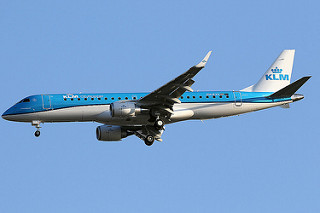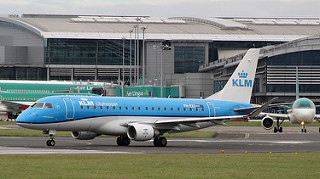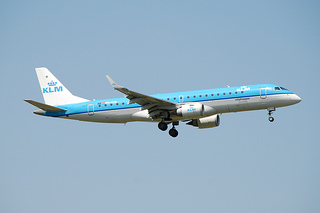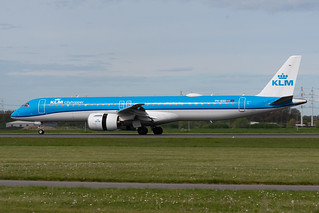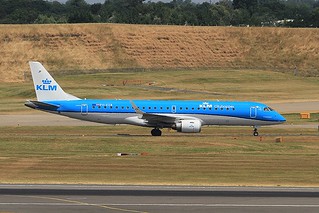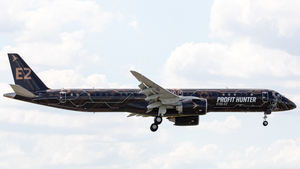KLM Cityhopper E190 and KLM B738 at Amsterdam on Jul 27th 2018, both cleared for takeoff from same runway different intersection, risk of collision
Last Update: June 15, 2020 / 15:01:07 GMT/Zulu time
Incident Facts
Date of incident
Jul 27, 2018
Classification
Report
Airline
KLM Cityhopper
Flight number
KL-1289
Departure
Amsterdam, Netherlands
Destination
Edinburgh, United Kingdom
Aircraft Registration
PH-EXV
Aircraft Type
Embraer ERJ-190
ICAO Type Designator
E190
A KLM Boeing 737-800, registration PH-BXI performing flight KL-1783 from Amsterdam (Netherlands) to Hamburg (Germany), had taxied to holding point on taxiway W4. While the ERJ was already moving the B738 was cleared to line up runway 18C.
The ERJ received takeoff clearance from runway 18C. When the Boeing crew heard the takeoff clearance, they stopped their aircraft past the hold short line and reported they "were on the runway". In response tower cleared the Boeing for takeoff, too.
When the ERJ crew, who had seen the Boeing clear of the runway and had so far continued takeoff, heard the takeoff clearance they rejected takeoff at high speed (just above 85 knots over ground). The Boeing did not move and remained stationary on taxiway W4 past the hold short line.
Shortly after the ERJ had rejected takeoff and was still slowing down the tower received a Runway Incursion Alerting System Schiphol (RIASS) warning. The controller cancelled the takeoff clearance for the E190.
The E190 came to a stop abeam taxiway W4, the two aircraft were separated by only 19 meters.
On Jun 15th 2020 the DSB reported in their Quarterly Bulletin, that they did not conduct an extensive investigation into the serious incident and cooncluded:
In the past, the Dutch Safety Board has concluded that safety risks can arise at Schiphol as a result of choices that result in complex handling of air traffic.3 An example of such a choice is the offering of intersection starts at Schiphol, as in this case. The Safety Board has expressed appreciation for the extensive report drawn up by the sector within the Integral Safety Management System (ISMS) system into this occurrence and broadly supports the conclusions of that report. In line with the conclusions of the ISMS report, the Safety Board believes that attention for previous incidents involving traffic controllers during their shift and continuing work following such occurrences is appropriate. Moreover, the Safety Board calls for attention for the relationship between this occurrence and the issuing in practice of intersection starts to air traffic at Schiphol.
The DSB wrote:
The take-off clearance to the E190 resulted in a potential (collision) hazardous situation because both aircraft – due to their different start positions – were simultaneously given authorized access to the same section of the runway, where high-energy aircraft movements take place. In this situation, the RIASS was revealed to not be an effective safety barrier; the system in fact only generated an alarm after the E190 had already started to decelerate, on its own initiative. The fact that both crews involved were communicating on the same radio frequency, and were able to see each other were effective safety barriers.
Use of intersection starts
Previous investigations have shown that the use of intersection starts can engender increased risks. These risks are further increased by using a (non-rightangled) high speed exit as an access to the runway, a situation which is advised against, internationally.1 As a consequence, once they have passed the hold short line approaching the runway, the aircraft crew experience difficulty in seeing other approaching traffic taking off from the start of the runway.
Workload runway controller
At the moment of the occurrence, the runway controller was supervising three runways: runways 18C and 09 which were in use for aircraft taking off, and runway 22 in use for aircraft both taking off and landing. Runway 18C is less often used for departing traffic, features non-standard exit and entrance numbers and also employs non-standard names for standard departure routes. The ISMS report concluded that the use of runway 18C as a runway for departing traffic, in combination with simultaneous use of other runways, can be referred to as an operation with increased complexity. The runway controller also increased his own workload by allowing the ground controller to offer the B737 an intersection start, rather than instructing the B737 to line up behind the E190.
Earlier in his shift, the runway controller had been involved in two other occurrences. Approximately 23 minutes before the occurrence, a light aircraft crossing the airport in the direction of the coast failed to follow his instructions. As a consequence, for some time, there was a risk to traffic taking off from runway 18C. The runway controller said that he had been shocked by this occurrence but after consulting with his supervisor stated he was able to continue his shift. Approximately 4 minutes before the occurrence, the runway controller also authorized an aircraft to taxi onto runway 18C via intersection W4, despite the fact that 15 seconds previously, he had issued clearance to another aircraft to take off on the same runway. Immediately after the aircraft crew read back the clearance to taxi, the runway controller withdrew the takeoff clearance.
Aircraft Registration Data
Incident Facts
Date of incident
Jul 27, 2018
Classification
Report
Airline
KLM Cityhopper
Flight number
KL-1289
Departure
Amsterdam, Netherlands
Destination
Edinburgh, United Kingdom
Aircraft Registration
PH-EXV
Aircraft Type
Embraer ERJ-190
ICAO Type Designator
E190
This article is published under license from Avherald.com. © of text by Avherald.com.
Article source
You can read 2 more free articles without a subscription.
Subscribe now and continue reading without any limits!
Read unlimited articles and receive our daily update briefing. Gain better insights into what is happening in commercial aviation safety.
Send tip
Support AeroInside by sending a small tip amount.
Related articles
KLM Cityhopper E190 at London on Jul 17th 2022, bird strike
A KLM Cityhopper Embraer ERJ-190, registration PH-EXV performing flight KL-992 from London City,EN (UK) to Amsterdam (Netherlands), was in the…
KLM Cityhopper E190 at Amsterdam on May 2nd 2019, bird strike
A KLM Cityhopper Embraer ERJ-190, registration PH-EXV performing flight KL-1733 from Amsterdam (Netherlands) to Brussels (Belgium), was climbing out…
KLM E190 at Amsterdam on Nov 15th 2018, loud bang and vibrations on departure
A KLM Embraer ERJ-190, registration PH-EXV performing flight KL-1057 from Amsterdam (Netherlands) to Bristol,EN (UK), departed Amsterdam's runway 24…
KLM Cityhopper E175 near Amsterdam on Apr 15th 2024, lightning strike
A KLM Cityhopper Embraer ERJ-175, registration PH-EXJ performing flight KL-1057 from Amsterdam (Netherlands) to Norwich,EN (UK), was climbing out of…
KLM Cityhopper E190 at Amsterdam on Apr 8th 2024, pressurization problem
A KLM Cityhopper Embraer ERJ-190, registration PH-EZB performing flight KL-1945 from Amsterdam (Netherlands) to Basel/Mulhouse (Switzerland/France),…
KLM Cityhopper E195 at Edinburgh on Jan 16th 2024, electrical problems
A KLM Cityhopper Embraer ERJ-195, registration PH-NXO performing flight KL-1279 from Amsterdam (Netherlands) to Edinburgh,SC (UK), was on approach to…
KLM Cityhopper E190 at Amsterdam on Dec 29th 2023, lightning strike
A KLM Cityhopper Embraer ERJ-190, registration PH-EZR performing flight KL-1357 from Amsterdam (Netherlands) to Prague (Czech Republic), was climbing…
KLM Cityhopper E295 at Berlin on Sep 12th 2021, takeoff from 1320 meters past prepared line up
A KLM Cityhopper Embraer ERJ-195-E2, registration PH-NXD performing flight KL-1830 from Berlin Brandenburg (Germany) to Amsterdam (Netherlands) with…
Newest articles
Easyjet A320 at Manchester on May 12th 2024, lightning strike
An Easyjet Airbus A320-200, registration G-EZPD performing flight U2-2179 from Manchester,EN (UK) to Amsterdam (Netherlands), was in the initial…
Canadian North AT72 at Cambridge Bay on Apr 14th 2024, runway excursion on landing
A Canadian North Avions de Transport Regional ATR-72-200, registration C-FRQA performing flight 5T-5858 from Yellowknife,NT to Cambridge Bay,NU…
Subscribe today
Are you researching aviation incidents? Get access to AeroInside Insights, unlimited read access and receive the daily newsletter.
Pick your plan and subscribePartner

A new way to document and demonstrate airworthiness compliance and aircraft value. Find out more.

ELITE Simulation Solutions is a leading global provider of Flight Simulation Training Devices, IFR training software as well as flight controls and related services. Find out more.

Your regulation partner, specialists in aviation safety and compliance; providing training, auditing, and consultancy services. Find out more.
AeroInside Blog
Popular aircraft
Airbus A320Boeing 737-800
Boeing 737-800 MAX
Popular airlines
American AirlinesUnited
Delta
Air Canada
Lufthansa
British Airways





